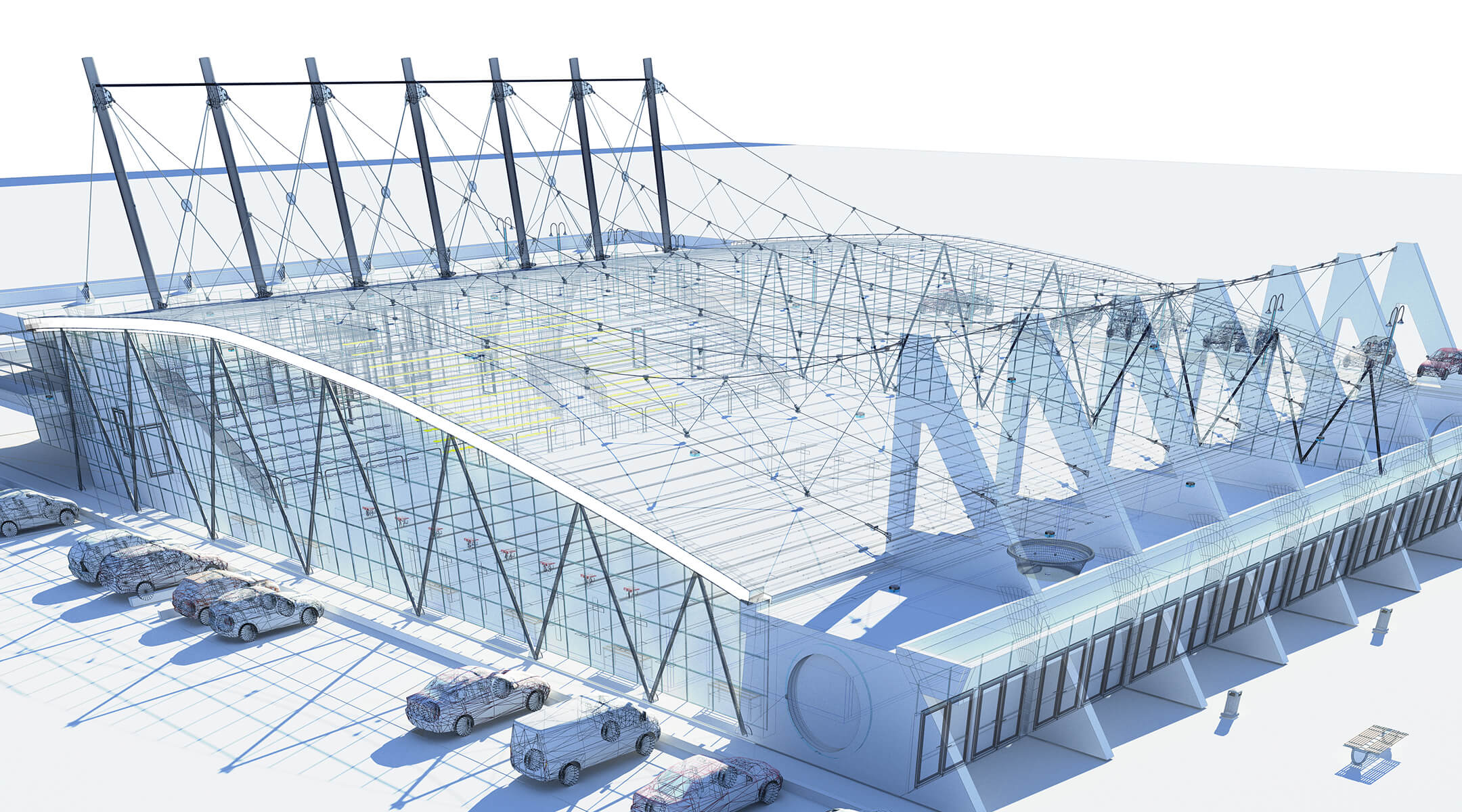Today, there’s a great number of ways to present an architect’s body of work. One can choose to create a website for this purpose or to design a digital or a printed brochure. To make an architecture professional portfolio stand out, many take a creative approach to filling it. They combine sketches, technical drawings, 3D renders, and mock-up photos. But with all those endless possibilities, it’s important to always keep in mind the reason for making that portfolio in the first place. And that’s getting clients. To attract them, a portfolio must not only please its owner’s eye, but consider prospects’ perception as well.
There are several tips an architect can use to make their portfolio eye-catching, easy to view and navigate through. In this article, an architecture professional will find some valuable advice on how to arrange the images and text to get the best effect. Also, they will learn about using different types of visuals, including those made with 3D architectural visualization, that help to show the projects in all their glory. Now, let’s take a look at the 7 ways to make an architecture portfolio shine!
#1. Find Your Own Style

First things first, an architect needs to find their own style. It should be something they are absolutely comfortable with because it must be maintained throughout the whole portfolio. Ideally, the style should resonate with the works, especially if they all have a common theme. For instance, if one designs minimalistic, ultra-efficient buildings, the architecture professional portfolio needs to carry on the idea, showing only as much as necessary. Furthermore, the use of negative space is something to be explored, as it can totally change the viewer’s perception.
Now, a personal style is not all about the visual presentation. It should reflect an architecture professional’s own philosophy and highlight their approach to work. After all, pretty pictures mean nothing if the client cannot find a common ground with their potential contractor. So, how does one go about it without ruining the impression altogether? Well, it does take some bravery, but one must be completely authentic.
For example, some architects put only one single project in their portfolio, if they think it’s enough to show all their best qualities. Then, some professionals stand out by defying digital formats. They’ll send their collection of images in a box to a potential client and won’t feel like they’re missing out on anything, not for a second. And, perhaps, that kind of confidence can tip the scales in their favor.
#2. Make It Easy to View

Now, whether an architecture professional portfolio is in the form of a website, a PDF file, or a printed brochure, it always must be easy to view. A website can benefit greatly from having a filter system that allows viewers to sort the entries by type of project, style, date, concept, etc. Moreover, optimization for viewing on mobile devices is an absolute must, since many people do a lot of their work on the go.
If we talk about PDFs, first of all, let’s say that it’s best to have one. Even if an architect’s website is insanely creative, or their printed presentation is to die for, a PDF file is the most convenient and trustworthy format. It can be made lightweight — under 15MB — with no loss of quality. And it can be opened on any device. However, it must have an impeccably clean and efficient layout, so that a prospect can get a good understanding of an author’s professional capabilities just by skimming it. Because, let’s be honest, that’s what they do.
#3. Add Descriptions

Text descriptions are essential for an architecture professional portfolio. They help to paint the full picture for the viewers, who may not understand all the technical details from images alone. In most cases, the text has a secondary value, but it doesn’t mean it can be written sloppily. So, firstly, an architecture expert needs to think very carefully about every project to write a concise, informative, and interesting description. Most importantly, it should highlight the main idea behind the design and specify the architect’s role in the project.
Naturally, descriptions mustn’t take up most of the space in a portfolio. So, if some concepts are difficult to cover in just a few sentences, one should consider using infographics-like elements for illustration. Step-by-step explanations are also a great way to showcase one’s professional workflow. And if an architect is not sure about the quality of their texts, they can always use professional copywriting services to make sure everything about their portfolio is perfect.
Showcase your architectural project like a true work of art, brought to life with cutting-edge AI-powered CGI technology.
#4. Use CGI

Nowadays, an architecture professional can hardly avoid using computer-generated imagery in their work. After all, it works magic, allowing to showcase projects that are still under construction as if they’re already complete. Moreover, 3D visualization for architecture makes it possible to adjust lighting, colors, backgrounds, and surroundings in the imagery according to the architect’s preferences. This way, it’s even easier to stay on-brand with absolutely unique visuals.
CGI can serve a variety of purposes in an architecture professional portfolio. For instance, one can use it in combination with sketches and technical drawings to show the process of developing a certain concept. Or, one can just fill a whole brochure spread or a webpage with a photorealistic 3D render to focus the viewer’s attention on the end result. The possibilities are endless here, with no limits as far as an architect’s imagination goes.
#5. Include Technical Drawings Smartly

Most architects feel compelled to include as many technical drawings in their portfolios as possible. That’s the basis of their work, after all. And, naturally, drawings deserve to be featured in an architecture professional portfolio, especially when there are complex original designs. However, it’s all too easy to clutter the space with lots of technical details that don’t quite contribute to forming a good impression in a prospect’s eyes.
Therefore, one should only include those drawings that showcase the most important and intricate design solutions. Also, an architect can give the plans and schemes a little makeover with color highlights and descriptions. For large-scale projects involving landscape design and integration of structures into natural surroundings, site plans are a must to give the idea of the scale of work. Those can take up whole spreads or webpages. But in most cases, it’s better not to place large-scale drawings in a portfolio, since people who will be viewing it are not architecture professionals.
#6. Make Sure Your Typography Is On Point

Even once the text in an architecture professional portfolio has been proofread for typos and unnecessary information, the work on it is still not over. To make things look truly stylish and thought-through, one must pay attention to the way that text is placed in a layout, its size, and, of course, fonts and typefaces. So, it might be useful to recap some typography basics.
The first step to success here is to select 2-3 typefaces that are consistent with the style of the images and the overall layout. Next, it’s all about proper placement and sizing. Here, following simple rules of typography like making headings 2x bigger than body text can take a professional portfolio a long way. Furthermore, it’s often a good idea to place small bits of text on top of or right next to pictures. As a result, it will help to tell a project’s story but won’t take the viewer’s attention away from the images.
#7. Use Various Content Formats
If one’s architecture professional portfolio is a website, it’s only reasonable to try and make the most out of it. For instance, there’s this great opportunity to use different types of visual content, such as videos and interactive 360-degree panoramas. Those can be created either by means of 3D visualization or regular photography if the building is already finished. One of the most popular ways to use videos in such cases is setting the best one on a website’s main page, full-size. And panoramas make wonderful additions to portfolio entries, especially for large-scale projects, such as parks or campuses.
So, those were the 7 tips that can definitely make an architecture professional portfolio shine. They might seem quite simple, but they cover all the basics of good design and are applicable to both digital and printed brochures, as well as websites. Overall, to create a truly outstanding self-presentation, any architect must remember to, first of all, be authentic. It’s never a good idea to blindly copy somebody else’s work. But looking at other professionals’ portfolios for inspiration is. Also, it’s important to keep in mind that all of this is not meant to indulge one’s creative ego. Rather, it’s meant to demonstrate one’s best qualities to potential clients.
Get your project estimated in just 1 hour - fill out this brief!
Are you interested in using millwork drafting services and 3D visualization services to take your portfolio to the next level? Contact us and get the most stunning architectural renders, animations, and panoramas for a reasonable price!

Ana Wayne
Content Writer, Copywriter
Ana is a content writer for ArchiCGI. She has a passion for design and architecture - and for talking about it. Outside of work, she is a fan of sci-fi movies and a street food connoisseur.



